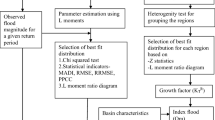Abstract
In this study, screening of the data has been carried out basedon the discordancy measure (D i) in terms of the L-moments. Homogeneity of the region has been tested using the L-moments based heterogeneity measure, H. For computing the heterogeneity measure H, 500 simulations were carried out using the four parameter Kappa distribution. Based on this test, it has been observed that the data of 8 out of 11 bridge sites constitute ahomogeneous region. Hence, the data of these 8 sites have been used in this study. Catchment areas of these 8 sites vary from 32.89 to 447.76 km2 and their mean annual peak floods varyfrom 24.29 to 555.21 m3 s-1. Comparative regional floodfrequency analysis studies have been carried out using the various L-moments based frequency distributions viz. Extreme value (EV1), General extreme value (GEV), Logistic (LOS), Generalized logistic (GLO), Normal (NOR), Generalized normal (GNO), Uniform (UNF), Pearson Type-III (PE3), Exponential (EXP),Generalized Pareto (GPA), Kappa (KAP), and five parameter Wakeby(WAK). Based on the L-moment ratio diagram and ∣ Z i dist ∣–statistic criteria, GEV distribution has been identified as the robust distribution for the study area. For estimation of floods of various return periods for gauged catchments of the study area, regional flood frequency relationship has been developed using the L-moments based GEV distribution. Also, for estimation of floods of desiredreturn periods for ungauged catchments, regional flood frequencyrelationship has been developed by coupling the regional flood frequency relationship with the regional relationship between mean annual maximum peak flood and catchment area.
Similar content being viewed by others
References
Central Water Commission: 1985, ‘Flood estimation for Middle Ganga Plain Subzone 1(f)’, Report No.GP/10/1984, Directorate of Hydrology (Small Catchments), New Delhi.
Chow, V. T.: 1962, Hydrologic Determination of Waterway Areas for the Design of Drainage Structures in Small Drainage Basins, University of Illinois, Eng. Exp. Sta. Bull., p. 462.
Farquharson, J. R.: 1992, ‘Regional flood frequency analysis in arid and semi arid areas’, J. Hydrol. 138, 487–501.
Greenwood, J. A., Landwehr, J. M., Matalas, N. C. and Wallis, J. R.: 1979, ‘Probability weighted moments: Definition and relation to parameters of several distributions expressible in inverse form’, Water Resour. Res. 15, 1049–1054.
Hosking, J. R. M. and Wallis, J. R.: 1986, ‘The value of historical data in flood frequency analysis’, Water Resour. Res. 22(11), 1606–1612.
Hosking, J. R. M. and Wallis, J. R.: 1988, ‘The effect of intersite dependence on regional flood frequency analysis’, Water Resour. Res. 24(4), 588–600.
Hosking, J. R. M.: 1990, ‘L-moments: Analysis and estimation of distributions using linear combinations of order statistics’, J. Royal Stat. Soc., Series B, 52, 105–124.
Hosking, J. R. M.: 1991, ‘Approximations for Use in Constructing L-moment Ratio Diagrams’, Res. Rep., RC-16635, 3, IBM Res. Div., T.J., Watson Res. Cent., Yorktown Heights, New York.
Hosking, J. R. M. and Wallis, J. R.: 1993, ‘Some statistics useful in regional frequency analysis’, Water Resour. Res. 29(2), 271–281.
Hosking, J. R. M. and Wallis, J. R.: 1997, Regional Frequency Analysis - An Approach Based on L-moments, Cambridge University Press, New York.
Iacobellis, V. and Fiorentino, M.: 2000, ‘Derived distribution of floods based on the concept of partial area coverage with a climatic appeal’, Water Resour. Res. 36(2), 469–482.
Jin, M. and Stedinger, J. R.: 1989, ‘Flood frequency analysis with regional and historical information’, Water Resour. Res. 25(5), 925–936.
Kumar, R., Singh, R. D. and Seth, S. M.: 1999, ‘Regional flood formulas for seven subzones of zone 3 of India’, J. Hydrol. Eng., ASCE, 4(3), 240–244.
Landwehr, J. M., Matalas, N. C. and Wallis, J. R.: 1979, ‘Probablity weighted moments compared with some traditional techniques of estimating Gumbel parameters and quantiles’, Water Resour. Res. 15(6), 1055–1064.
Martins E. S. and Stedinger, J. R.: 2000, ‘Generalised maximum-likelihood generalised extremevalue quantile estimators for hydrologic data’, Water Resour. Res. 36(3), 737–744.
National Institute of Hydrology: 1992, Hydrologic Design Criteria, Course Material of Regional Course on Project Hydrology, Roorkee.
National Institute of Hydrology: 1996, ‘Development of Regional Flood Frequency Relationships and Flood Formulae for Various Subzones of Zone 3 of India’, Technical Report, TR(BR)-149.
Peel, M. C., Wang, Q. J., Vogel, R. M. and McMahon, T. A.: 2001, ‘The utility of L-moment ratio diagrams for selecting a regional probability distribution’, Hydrol. Sci. J. 46(1), 147–156.
Pilgrim, D. H. and Cordery, I.: 1992, ‘Flood Runoff’, in D. R. Maidment (ed.), Handbook of Hydrology, Chapter 9, McGraw-Hill, Inc., New York.
Potter, K. W. and Lettenmaier, D. P.: 1990, ‘A comparison of regional flood frequency estimation methods using resampling method’, Water Resour. Res. 26, 415–424.
Research Design and Standards Organization: 1991, ‘Estimation of Design Discharge Based on Regional Flood Frequency Approach for Subzones 3(a), 3(b), 3(c) and 3(e)’, Bridges and Floods Wing Report No. 20
Stedinger, J. R., Vogel, R. M. and Foufoula-Georgiou, E.: 1992, ‘Frequency Analysis of Extreme Events’, in D. R. Maidment (ed.), Handbook of Hydrology, Chapter 18, McGraw-Hill, Inc., New York.
Vogel, R. M. and Fennessey, N. M.: 1993, ‘L-moments should replace product moments diagrams’, Water Resour. Res. 29(6), 1745–1752.
Wallis, J. R. and Wood, E. F.: 1985, ‘Relative accuracy of Log-Pearson III Procedures’, J. Hydraul. Eng., ASCE, 111(7), 1043–56.
Zafirakou-Koulouris, A., Vogel, R. M., Craig, S. M. and Habermeier, J.: 1998, ‘L-moment diagrams for censored observations’, Water Resour. Res. 34(5), 1241–1249.
Author information
Authors and Affiliations
Rights and permissions
About this article
Cite this article
Kumar, R., Chatterjee, C., Kumar, S. et al. Development of Regional Flood Frequency Relationships Using L-moments for Middle Ganga Plains Subzone 1(f) of India. Water Resources Management 17, 243–257 (2003). https://doi.org/10.1023/A:1024770124523
Issue Date:
DOI: https://doi.org/10.1023/A:1024770124523




